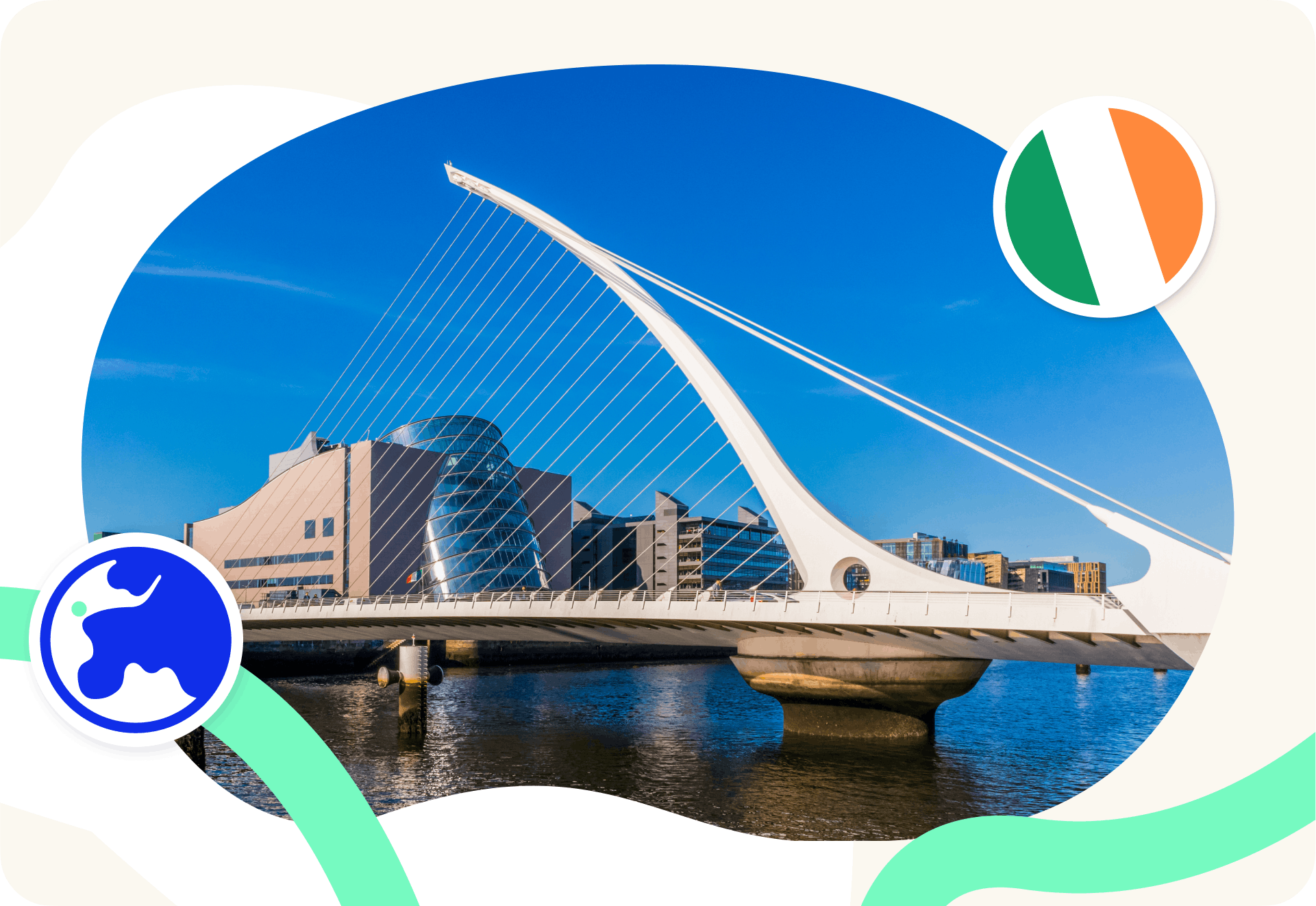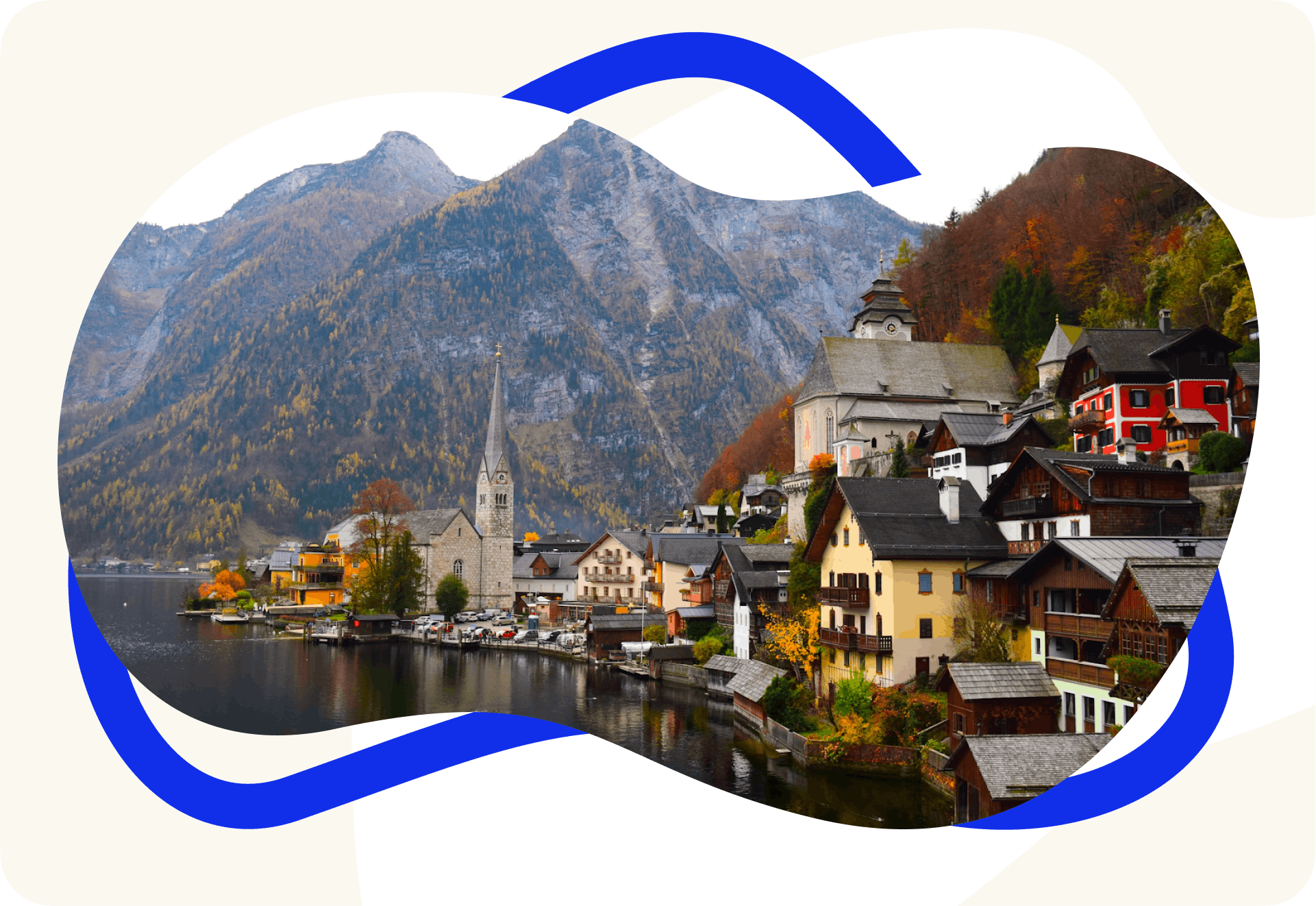Moving to Ireland? Whether you're planning employee hiring, move for work, join a family member, or simply immerse yourself in a new country and enjoy the Emerald Isle for its rich culture and friendly communities, it's important to understand the Irish immigration process, how it works, and how the Ireland Stamp 4 visa could be your ticket to a top o' the morning!
What is an Ireland Stamp 4 visa?
Ireland's immigration system uses a "Stamp" system that categorizes the type of residency permission granted to applicants. The Stamp 4 offers residency permission for employees, investors, and individuals seeking long-term residency or a path to citizenship.
Who is eligible for the Irish Stamp 4?
Eligibility for Stamp 4 varies based on your circumstances. Common paths to eligibility include:
- Renewing a Research Permit (via Hosting Agreement) or a Critical Skills Employment Permit.
- Having held another type of work permit in Ireland for at least 5 years.
- Joining a spouse, civil partner, or de facto partner who is either an Irish citizen or an EU/EEA/Swiss national.
- Being a recognized refugee or otherwise granted subsidiary protection.
- Being an investor or entrepreneur under specific programs.
Each pathway has its own set of requirements, such as how long you can stay in Ireland, if you require past stays in Ireland, the nature of your job or relationship, and your legal status in the country.
Once you're granted permission for your stay, you must register your permission and immigration status with:
- Immigration Service Delivery (ISD): If you'll be living in City Dublin or County Dublin.
- Garda National Immigration Bureau (GNIB): If you'll be living anywhere else within Ireland.
What documents are required for the Ireland Stamp 4 visa?
The paperwork you'll need for a Stamp 4 application can vary depending on your path to eligibility.
Generally, you'll need:
- A current passport and any previous passports that contain Irish stamps or visas.
- Evidence of your relationship to an Irish citizen or EU/EEA/Swiss national, if applicable.
- Proof of employment or self-employment, including tax compliance.
- Documentation of your residency in Ireland, such as utility bills or a lease agreement.
Any letters or certificates from the Department of Justice or other Irish government bodies related to your immigration status can also help.
How to apply for Stamp 4?
The application process for Stamp 4 depends on your unique circumstances. The typical process involves:
Eligibility check
Before applying for Stamp 4, you must ensure that you meet the eligibility criteria.
If you currently live in Ireland, eligibility requirements vary depending on your reason for applying. For instance, some of the Stamp 4 eligibility requirements for a long-term residency application include:
- A valid Critical Skills Employment Permit for 2 years.
- Compliance with all your previous immigration permissions.
- Legal residency at the time of application.
- Employment in Ireland before, during, and after your application (Note: self-employment is not permitted).
If you do not live in Ireland, you can apply for the Stamp 4 if you fall into one of the following categories:
- Those who are currently residing temporarily and seeking to establish long-term residency.
- Entrepreneurs who are part of the Start-up Entrepreneur Program (STEP).
- Investors who are participating in the Immigrant Investor Program.
- Foreign nationals who are married to, in a civil partnership with, or in a de facto relationship with an Irish citizen.
- Individuals who have been granted refugee status through a convention or program.
- Refugees who have been granted subsidiary protection.
- Family members of a recognized refugee.
- Relatives of a resident who has been granted subsidiary protection.
- Parents of an Irish citizen.
Application process
To apply for an Irish Stamp 4 visa, you must:
- Gather required documents: Collect all necessary documents, which may include proof of identity, marriage or civil partnership certificates (if applicable), employment permits, and any other supporting documents relevant to your application.
- Fill out the online application: Most applications for Stamp 4 are submitted online through the Irish Naturalisation and Immigration Service (INIS) website. You will need to create an account, complete the online application form, and pay the appropriate fee.
- Attend a biometric appointment: Depending on your nationality, you may be required to attend a biometric appointment at a designated application center.
- Attend an interview: In some cases, you may be called for an interview with immigration officials.
- Wait for your Stamp 4 decision: The processing time for Stamp 4 applications can vary, but you can typically expect to receive a decision within a few months.
- Register your Stamp 4 immigration permission: Once your application is approved, you must register your permission with Immigration Service Delivery (ISD) or the Garda National Immigration Bureau (GNIB) within 90 days.
Stamp 4 visa process for B2B and HR managers
Understanding the process is crucial for businesses and HR managers looking to help employees obtain the Stamp 4 visa. Eligibility for Stamp 4 often depends on having spent a specified period of time in Ireland, holding certain types of employment permits, or being a family member of an Irish citizen or permanent resident. Applications should generally be done online, with the necessary documentation outlined above to support the applicant's eligibility.
Latest news and developments regarding the Ireland Stamp 4 visa
As of November 30, 2023, the Department of Justice (DOJ) has assumed assessment responsibilities concerning Stamp 4 applications, and the Department of Enterprise will no longer play a role in the eligibility assessment process. This change is expected to streamline the application process by removing a previously required step that involved the Department of Enterprise, Trade, and Employment (DETE).
Recent updates to Stamp 4 immigration have focused on:
Streamlining the application process
In an effort to make the immigration journey smoother, the Irish Naturalisation and Immigration Service (INIS) has been streamlining the application process for the Stamp 4 visa. This includes introducing online application systems to reduce paperwork and processing times.
The online portal allows applicants to fill out and submit their forms digitally, ensuring a more efficient and user-friendly experience. Additionally, INIS has been updating its website with clearer instructions and guidelines to help applicants understand the requirements and steps involved in the application process.
Expanding eligibility
Recent developments in Irish immigration policy have seen an expansion in the eligibility criteria for the Stamp 4 visa. This is part of Ireland's strategic approach to support family reunification and to attract and retain talent in key sectors.
Changes include broadening the categories of work permits that can lead to Stamp 4 eligibility and reducing the time required to transition from other stamp categories to Stamp 4. For instance, individuals with a General Employment Permit can apply for Stamp 4 after 21 months rather than the previously required 24 months. These changes reflect Ireland's commitment to being an attractive destination for skilled professionals and their families.
At Localyze, we aim to provide you with the most comprehensive guide to the Irish Stamp 4 visa application process—but a truly all-encompassing look at immigrating to another country goes far beyond just obtaining your visa.
Other common Irish immigration Stamps
The Irish immigration system uses various other Stamp Visas to categorize and regulate the stay of non-European Economic Area (non-EEA) nationals. Each Stamp serves a specific purpose and corresponds to different types of employment, study, or residence situations. Below you can find information on some of the most common Irish Stamps.
What is a Stamp 1?
A Stamp 1 grants you permission to work or operate a business in Ireland. To obtain a Stamp 1 permission, you must hold a valid employment permit or a letter from ISD stating that you can work without an employment permit. This means that your employer needs to obtain an employment permit for you before you can start a job, unless your letter of permission states that you do not require a work permit.
What is a Stamp 1A?
A Stamp 1A is granted for accountancy traineeships. This permission is a time-bound permission and you must complete your accountancy trainee within 4 years.
What is a Stamp 1G?
A Stamp 1G indicates that you are allowed to look for employment after you've finished your studies in Ireland under the Third Level Graduate Programme. It is granted only for 12 months, unless you have completed a master’s degree program, in which case you are eligible for additional 12 months.
Stamps 1G may also be given to spouses or de facto partners of a CSEP holder or of researchers in the State on a Hosting Agreement. Stamp 1G allows you to take up employment without the need to obtain an employment permit.
The following employment conditions apply for spouses and de facto partners of CSEP holders and researchers on a Hosting Agreement permission:
- You are allowed to work in Ireland without a work permit
- You are allowed to study in Ireland
- You are not allowed to establish or operate a business
- You are not allowed to be self-employed
- You can apply every year for a renewal of the Stamp 1G. After 5 years, you may apply for a Stamp 4
- The periods you spend on a Stamp 1G are considered as reckonable residence and allow you to apply for citizenship or naturalisation
What is a Stamp 2?
To study in Ireland, you will be granted a Stamp 2 permission. After you complete your studies you may turn the Stamp into a Stamp 1G or Stamp 1 if you apply for an employment permit.
What is a Stamp 3?
You may be granted a Stamp 3 if you have permission to:
- Volunteer, for example with a charity or non-profit organisation
- Be a minister of religion
- Join your non-EEA/EU/Swiss spouse/civil partner or family member who is in Ireland on a work permit.
What's it like to live in Ireland?
Moving to a new country means adapting to a new culture, lifestyle, and environment. Immigration can be a significant change from what you're used to, so in preparation, here's some information to help you imagine your potential new life in Ireland.
Ireland is known for its warm hospitality, stunning landscapes, and rich history, but did you know it also offers a strong education system? Ireland's universities are among the best in the world, particularly in areas like technology and the sciences—that's one of the reasons Ireland is such a thriving hub for industries like technology, pharmaceuticals, and finance.
And there aren't many places where you can hike through the countryside, stroll the grounds of a medieval castle, marvel at its 11th-century craftsmanship, and then close out the night at a local pub with live music.
These tips can enrich your new life with greater confidence and appreciation for the country's unique heritage:
- Show an interest in the rich, cultural traditions of the Irish people. Locals love to share stories about and insights into their culture. Taking a genuine interest can help foster positive connections with the local community.
- Attend any of the annual cultural festivals where Ireland celebrates music, literature, and the arts.
- Get involved in local events or volunteering opportunities to meet new people and contribute to your new community.
Visiting Ireland's famous castles and landscapes
Blarney Castle in County Cork is infamous for the Blarney Stone, which, according to legend, gives the gift of eloquence to those who kiss it. Trim Castle in County Meath, the largest Anglo-Norman castle in Ireland, has been a filming location for several movies, including "Braveheart." Both castles are open to the public, offering guided tours and a glimpse into Ireland's medieval past.
The Cliffs of Moher are one of the country's most visited natural attractions, offering stunning views of the Atlantic Ocean—viewing the cliffs from the waters of the Atlantic is pretty spectacular, too.
The Ring of Kerry is a scenic drive around the Iveragh Peninsula that showcases the country's diverse landscapes. On this drive, you'll see everything from rugged coastline to rolling hills and lush green pastures.
The Giant's Causeway in County Antrim is one of UNESCO's World Heritage sites. You've likely seen pictures of this geological wonder's unique hexagonal basalt columns in National Geographic or watched documentaries of the region on the History Channel.
Learn about Irish history—past and present
Speaking of history, Ireland's is rich and complex. The island has seen the rise and fall of various kingdoms, invasions by the Vikings and Normans, and centuries of English rule, culminating in the struggle for independence in the early 20th century. Historical landmarks such as the ancient passage tomb at Newgrange, the medieval Rock of Cashel, and the iconic Dublin Castle bear witness to this storied past.
Global giants like Google, Facebook, and Apple established European headquarters in Dublin. The pharmaceutical industry is also significant, with companies like Pfizer, Johnson & Johnson, and Roche having major operations in the country. In finance, Ireland is home to many international banks and insurance companies, as well as a growing fintech sector.
Get to know the Irish people
The Irish people are known for their friendliness and hospitality. They have a strong sense of community and a deep appreciation for their cultural heritage, which includes a rich literary tradition, the Irish language (be sure to brush up on your Irish slang!), and traditional music and dance. The Irish are also passionate about sports, with games like rugby and soccer being the most popular.
Discover Irish music, culture, and famous pubs
Ireland is renowned for its vibrant pub culture, which is an integral part of the country's social fabric, as is music—traditional Irish music sessions are a common feature in pubs across the country. These sessions, known as "seisiúns," involve musicians gathering to play traditional Irish tunes, often with members of the public joining in.
Pubs in Ireland are so much more than just places to drink a pint—or to "go on the gargle" and get a little "langered," as the Irish say. These are community hubs where people gather to enjoy good music, great conversation, and, most of all, the warmth of Irish hospitality.
Here are some of the most popular pubs in Ireland, what makes them unique, and why the locals love them:
The Temple Bar, Dublin
Perhaps one of Dublin's most iconic and photographed pubs, The Temple Bar is at the heart of the city's cultural quarter. Known for its bright red exterior, extensive whiskey collection, and live music performances, The Temple Bar attracts both tourists and locals alike. It epitomizes the lively atmosphere of Dublin's Temple Bar area, making it a must-visit for anyone looking to experience the city's bustling nightlife.
Sean's Bar, Athlone
Sean's Bar in Athlone holds the Guinness World Record for the oldest pub in Ireland, and possibly the world, with its history tracing back to 900 AD. The pub is loved for its warm, welcoming atmosphere. Visitors can enjoy a pint by the open fire, explore the ancient artifacts found during renovations, and listen to the stories of its past told by locals whose families have lived in the region for hundreds of years, adding to the unique experience of visiting Sean's Bar.
Can you see yourself in Ireland? Localyze can help
Securing a Stamp 4 is a significant achievement in your employees' Irish immigration journey, offering the freedom to work and live in Ireland with fewer restrictions. Whether they're moving for work, family, or you're relocating your employees, understanding the Stamp 4 process is essential. If you're looking for expert guidance and support in navigating the complexities of Irish immigration, Localyze is here to help. Contact us today to take a significant step towards compliance and securing your talent's future in Ireland.




